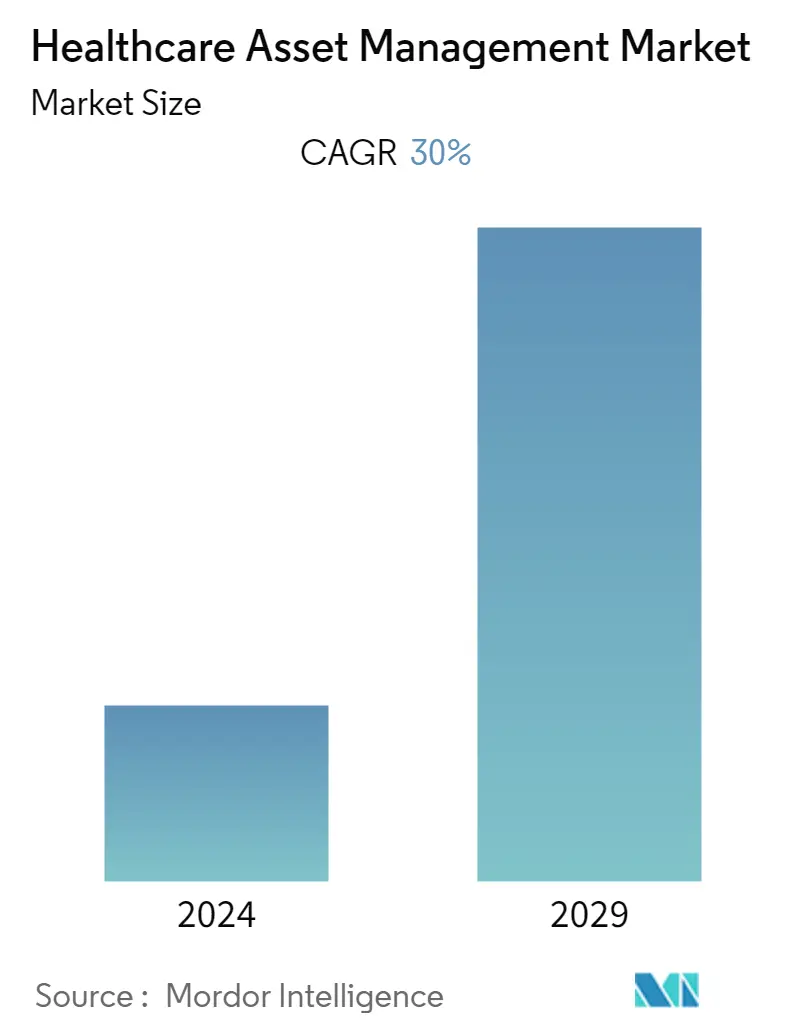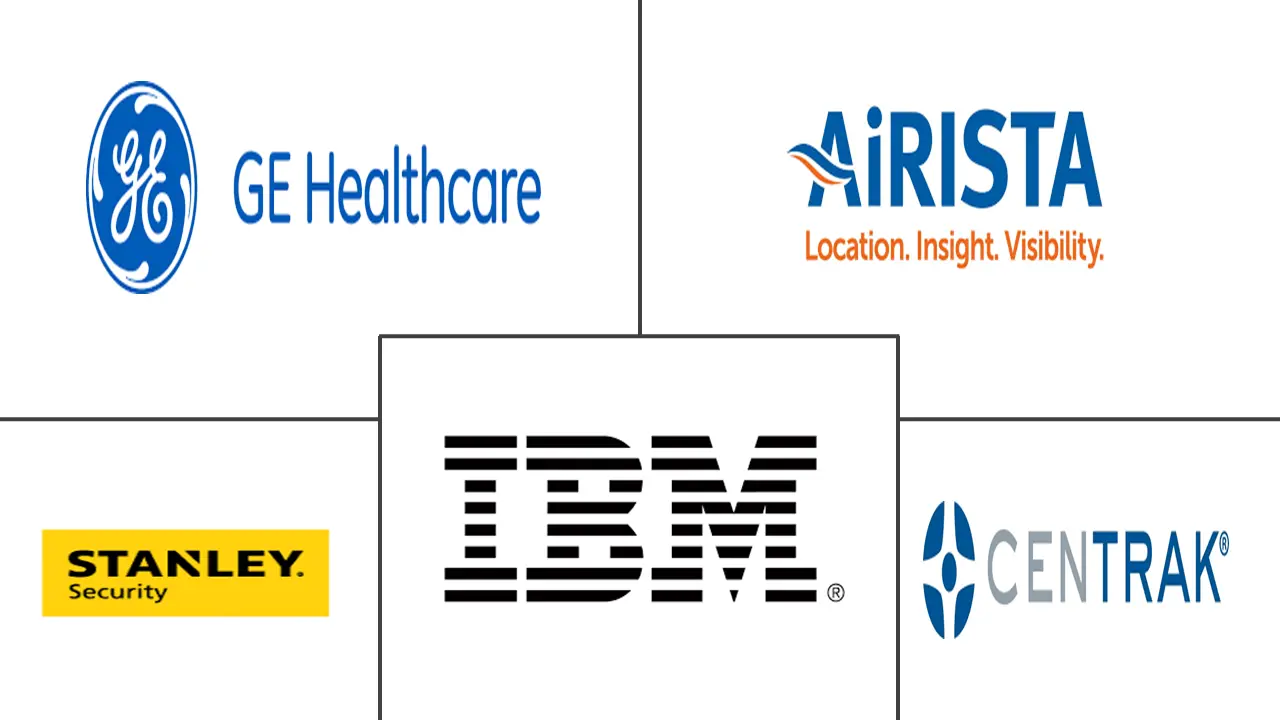Market Size of Healthcare Asset Management Industry

| Study Period | 2019 - 2029 |
| Base Year For Estimation | 2023 |
| CAGR | 30.00 % |
| Fastest Growing Market | Asia Pacific |
| Largest Market | North America |
| Market Concentration | High |
Major Players
*Disclaimer: Major Players sorted in no particular order |
Healthcare Asset Management Market Analysis
The healthcare asset management market is expected to register a CAGR of 30% over the forecast period. Healthcare asset management is a systematic and cost-effective strategy to plan, acquire, operate, and dispose of a healthcare organization's equipment and physical assets. The primary factors that encourage adopting healthcare asset management in healthcare organizations are keeping track of medical devices, high operating costs, time savings, enhanced patient care, higher staff productivity, significant cost savings, and intense maintenance.
- Real-time location systems (RTLS) and radio frequency identification devices are crucial instruments for healthcare asset management (RFID). The increased demand for improving efficiency and the rising integration of cloud computing, electronic health records, and other digital systems in hospitals is driving the market. However, low awareness and innovation in this sector in low and middle-income countries is a significant challenge for the Healthcare Asset Management Industry.
- Hospitals are increasingly adopting automated workflows and intelligent business analytics to ease the burden on their staff to improve workflow bottlenecks. Real-time Location Systems (RTLS) are poised to find widespread usage in healthcare asset management systems. The ability to manage multitasking involved in data capturing, integration, visualization, and analysis to enhance reliability is anticipated to drive market growth.
- Furthermore, the growing focus on existing assets' effective management along with the workforce has propelled numerous facilities of medical worldwide to adopt efficient management technologies and solutions of investments, therefore enlarging market growth of healthcare asset management.
- In urgent circumstances, the patient's state can change in a matter of seconds, and if the effectiveness of the operations is poor, the patient could perish. An additional driver of the asset management market in the healthcare system is the growing demand to increase hospital operational efficiency. However, the outdated healthcare infrastructure and worries over data privacy are a few factors that prevent using these technologies.
- The COVID-19 pandemic has brought the entire world to a grinding halt. Businesses have either shut down or are operating at a diminished capacity. With production cycles impacted, supply chains are being distorted, leading to shortages of consumer products.
Healthcare Asset Management Industry Segmentation
Healthcare asset management involves managing and maintaining machinery, equipment, and physical assets efficiently and cost-effectively. It generally includes pumps, refrigeration, plumbing, wheelchairs, condensers, generators, compressors, mobile beds, and heating, ventilation, and air-conditioning (HVAC) systems within a hospital. It saves time and money, improves asset utilization rate, locates equipment quickly, maintains appropriate inventory stock, and boosts staff communication.
The Healthcare Asset Management Market is Segmented by Application (Staff Management, Equipment Tracking, Patient Tracking, Supply Chain Management), End User (Hospital/Clinic, Laboratory, Pharmaceutical), and Geography (North America (US, Canada), Europe (Germany, UK, France, and Rest of Europe), Asia Pacific (India, China, Japan, and Rest of Asia-Pacific), Latin America (Brazil, Argentina, and Rest of Latin America), and Middle East & Africa (UAE, Saudi Arabia, South Africa, and Rest of Middle East & Africa)).
The market sizes and forecasts are provided in terms of value (USD million) for all the above segments.
| By Application | |
| Staff Management | |
| Equipment Tracking | |
| Patient Tracking | |
| Supply Chain Management |
| By End User | |
| Hospital/Clinic | |
| Laboratory | |
| Pharmaceutical |
| By Geography | ||||||
| ||||||
| ||||||
| ||||||
| ||||||
|
Healthcare Asset Management Market Size Summary
The healthcare asset management market is poised for significant growth, driven by the increasing need for efficient management of medical devices and physical assets within healthcare organizations. This systematic approach not only helps in tracking and maintaining equipment but also contributes to substantial cost savings, enhanced patient care, and improved staff productivity. The integration of advanced technologies such as real-time location systems (RTLS) and radio frequency identification (RFID) devices is pivotal in this sector, facilitating better data capture, integration, and analysis. Despite the challenges posed by low awareness and innovation in low and middle-income countries, the market is witnessing a surge in demand due to the rising adoption of cloud computing and digital systems in hospitals. The COVID-19 pandemic has further underscored the importance of robust asset management systems, particularly in curbing counterfeit incidents in pharmaceutical procurement.
North America stands out as a key region in the healthcare asset management market, benefiting from its advanced healthcare infrastructure and high penetration of IT solutions. The region's pharmaceutical industry, which accounts for a significant portion of the global market, is a major driver of demand for asset management systems. The growing use of IoT and RTLS for patient and asset tracking is enhancing operational efficiency in hospitals. The presence of major industry players like IBM Corporation, GE Healthcare, and Zebra Technologies Corporation in North America ensures competitive pricing and a variety of customer options. Collaborations and acquisitions among leading companies, such as GE Healthcare's partnership with Medtronic and Crothall Healthcare's acquisition of ABM's clinical engineering organization, are further propelling market growth by enhancing operational capabilities and service offerings.
Healthcare Asset Management Market Size - Table of Contents
-
1. MARKET INSIGHTS
-
1.1 Market Overview
-
1.2 Industrial Value Chain Analysis
-
1.3 Industry Attractiveness - Porter's Five Forces Analysis
-
1.3.1 Bargaining Power of Suppliers
-
1.3.2 Bargaining Power of Buyers/Consumers
-
1.3.3 Threat of New Entrants
-
1.3.4 Threat of Substitute Products
-
1.3.5 Intensity of Competitive Rivalry
-
-
1.4 Assessment of Impact of COVID-19 on the market
-
-
2. MARKET SEGMENTATION
-
2.1 By Application
-
2.1.1 Staff Management
-
2.1.2 Equipment Tracking
-
2.1.3 Patient Tracking
-
2.1.4 Supply Chain Management
-
-
2.2 By End User
-
2.2.1 Hospital/Clinic
-
2.2.2 Laboratory
-
2.2.3 Pharmaceutical
-
-
2.3 By Geography
-
2.3.1 North America
-
2.3.1.1 United States
-
2.3.1.2 Canada
-
-
2.3.2 Europe
-
2.3.2.1 Germany
-
2.3.2.2 United Kingdom
-
2.3.2.3 France
-
2.3.2.4 Rest of Europe
-
-
2.3.3 Asia-Pacific
-
2.3.3.1 China
-
2.3.3.2 Japan
-
2.3.3.3 India
-
2.3.3.4 Rest of Asia-Pacific
-
-
2.3.4 Latin America
-
2.3.4.1 Brazil
-
2.3.4.2 Argentina
-
2.3.4.3 Rest of Latin America
-
-
2.3.5 Middle East & Africa
-
2.3.5.1 UAE
-
2.3.5.2 Saudi Arabia
-
2.3.5.3 South Africa
-
2.3.5.4 Rest of Middle East & Africa
-
-
-
Healthcare Asset Management Market Size FAQs
What is the current Healthcare Asset Management Market size?
The Healthcare Asset Management Market is projected to register a CAGR of 30% during the forecast period (2024-2029)
Who are the key players in Healthcare Asset Management Market?
Stanley Security Solutions Inc., CenTrak Inc., AiRISTA Flow Inc., GE Healthcare Inc. and IBM Corporation are the major companies operating in the Healthcare Asset Management Market.

